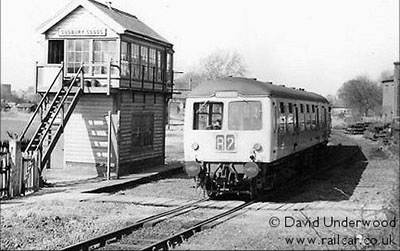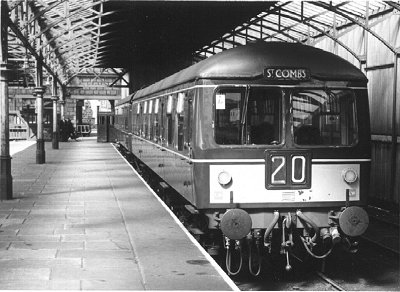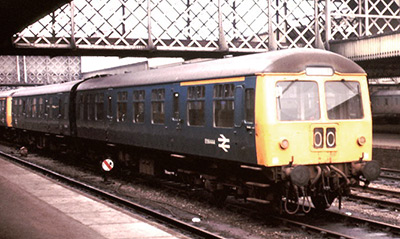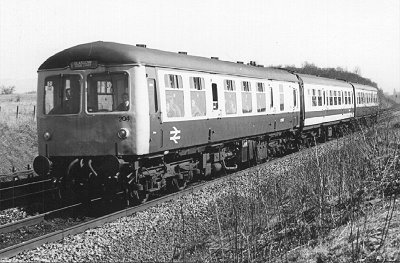Class 105/6 Cravens 2 & 3-car DMUs
Liveries

Green without whiskers
The sets were delivered in DMU green with cream lining. The first vehicles did not have whiskers.
The image shows M56147 in Birmingham New Street on May 31st, 1958. Note the shed code 6G (Llandudno Junction) painted on the buffer beam. Michael Mensing.
Green with whiskers
By 1958 whiskers were applied to the sets. The image shows the 6.08pm Aberdeen to Ballater seen at Park station, 19th May 1959. Hamish Stevenson
Green with yellow panel
The whiskers gave way to yellow warning panels on the lower cab front in 1962, often still with red buffer beams and grey roofs. Vehicles from E50379 on were delivered new with the blue square added, earlier vehicles had it applied soon after they started appearing. The ER batch one sets with route indicators (50370-4 / 56125-9) all had a yellow panel by June '57.
The image shows the 2:15pm to St. Combs awaiting departure from Fraserburgh on 24th April 1965. Hamish Stevenson
In the last days of green at least one ScR set had a full yellow end, and their sets would also carry a yellow first class stripe in green.
The sets would have the letters LW painted above the buffer beam, either in white on the blue square or latterly in black on the yellow.
Green with full yellow end
At least four vehicles are known to have received a full yellow end while still in green livery. One was a Scottish Cravens DTC - seen in this flickr image, one a LMR DMS (M50805) seen in this flickr image. The other two were both ER DMBSs, an image of one appeared on the front cover of the 1970 Ian Allan DMU ABC, the second appears on p42 of the book Looking Back at DMUs - 2.

Rail Blue with small yellow panel
In 1966 rail blue bagan to be applied to the vehicles. In the initial period some received just small yellow panels, the BR logo on the cab doors and red buffer beams. The first image shows this on a vehicle at Derby with a working to New Street, on September 3rd 1966. Andy Cole.

The LMR vehicles received a yellow panel similar in size to that applied in green, but NER / ER vehicles painted at Doncaster had a larger yellow panel covering the complete lower half of the cab front. One vehicle with this is seen at Peterborough with the 12:18 Peterborough - Leicester on 02/12/1967. Nigel Walls.

Rail Blue with yellow cab doors
In the late sixties all-over rail blue became the standard. In the initial period of this livery some received just small yellow panels, the BR logo on the cab doors and red buffer beams, and others then had full yellow ends wrapped round to include the cab doors. The image shows an example of the latter, a down train arriving at Sudbury in June 1969. David Underwood.
Standard Rail Blue
A 2 car unit with E56444 closest is seen at Sheffield Midland, 10-1-73. Note the interesting route indicator display. John Reddyhoff
Many Stratford units operating in the East London area until electrification in May 1986 appeared with white cab roofs.
Diddyland
Not stricly a livery, but in the summer of 1970 a two-car Cravens and a four-car Class 104 were decorated to publicise the Scarborough branch. On a day in June 1970 they operated two "Classroom Specials" carrying 300 children, one from Hull and one from Scarborough, running via Bridlington and passing at Driffield.
Simon Lee adds "BR invited schools along the line from Scarborough to Hull to nominate two pupils for two special trains. I was picked from my school, and went from Hull to Scarborough and back on the two-car Cravens. Both sets were decorated with stickers with flower comic symbols etc, the theme coming from the Ken Dodd show which was on at Scarborough for the season. Ken Dodd joined both trains swopping over at Driffield. Both units ran with the stickers on for a few weeks after the event. As an aside, there was a story/art competition for the kids who went on the trips, I was one of 5 boys who won the story prize, which was a Triang DMU (Blue Met Cam) presented by Ken Dodd at the Futurist Theater Scarborough later in 1970."
On the day of the school run Driffield was renamed 'Diddy Town' and Ken Dodd was wearing a guard's uniform. An image of part of the train, taken on July 15 1970, appeared in the December 1970 issue of Railway Magazine.
The DTC is believed to have been E56137, noted on 25/01/71 with "the remnents of what appeared to be white lining out and floral transfers, not properly removed".[1]
Blue Grey
From around mid 1979, the Scottish Region applied Blue/Grey livery to all of its remaining indigenous Class 105 vehicles, all of which were MBS cars that had been new to Scotland in power trailer sets.
By 1979 these were running in mixed sets with Metro Cammell Class 101 vehicles which were destined to be painted Blue/Grey. The Cravens MBS cars were planned to be kept long enough that it was worthwhile painting them to match.
All nine remaining Cravens MBS cars at Haymarket in mid 1979 went Blue/Grey: -
51473 51474 51475
51476 51477 51479
51480 51481 51483
By November 1981 these vehicles had all been withdrawn. They were the only Cravens DMU vehicles to be painted in this livery.
In the image Hybrid set number 204 features a Class 105 DMBS in Blue/Grey, a Class 101 centre car in refurbished livery, and a Class 101 DMS in Blue/Grey. Seen at Cadder on the 5th April 1980. Hamish Stevenson.

The Rolling Billboard
One set, after being withdrawn from passenger use became a mobile billboard, painted in advertisements. Vehicles 50759/50792 were partially repainted at Chester diesel depot in late 1981, with red lower panels beneath a thick white band. It was to promote new "London Saver" tickets, and "London Saver" appeared in large letters on the red sides, as well as some slogans and specimen fares from the Cambrian line and North Wales area on the white stripe. Each saloon window had large posters with details of the offers.
The promotion was arranged by BR's Stoke Division management team and the set was first used on Monday 3rd November 1981 coupled to the 10.42 from Shrewsbury to Aberytswyth. The Class 105 vehicles were not for passenger use. The marketing team travelled on the train and handed out leaflets at stations en-route. On the return the vehicles were detached at Machynlleth to do the Pwellheli section the next day. That week it also covered the Cambrian Coast, North Wales and Conwy Valley lines. On the 22nd March '82 it attended the opening of the new Blaenau Ffestiniog station. By Sep '82 the vehicles were at Carlisle Kingmoor for the stripping of useful parts.
Retro-Green
In April 1986 vehicles 53359 (the first built) and 54122 were repainted into original lined green livery by Stratford. The buffers and cab window surrounds were picked out in silver (they were originally polished), and the buffer beams were red. Because the vehicles had to have a yellow panel - this was below the lower cream stripe and extended round to stop at the cab doors - speed whiskers were added in black. It had a pale grey roof, and the crest was only applied to the left hand coach. For a time it also had a red band above the cab windows which extended up to the rainstrip and around the destination box. Pictured at Wolverton Works, 1/10/88. Robert Frise
Express Parcels
The parcels conversions were all standard blue, and at least one pair (including 53369) had the Parcels Sector waist band of yellow above red, and some had "Express Parcels" lettering on the side.
The image shows 53369 (closest) and 53367 at Leeds City on the 20th June 1987. Hamish Stevenson

Departmental
At least one of the vehicles (977126) converted for route learning duties on the ECML York diversion had large white lettering on the side "Route Learning Saloon" and underneath in smaller text "Chief Operating Manager". It retained it's all-blue livery. Peter, LEYTR
References
- ⋏ p107 March 1971 Railway Observer (Railway Correspondence and Travel Society)
Summary
Orders
Description - General
Description - Variations
Description - Interior
Works Photos & Drivers Inst.
Diagrams
Numbering
Liveries
Operations - Batch One
Operations - Batch Two
Operations - Batch Three
Operations - Batch Four
Operations - Scotland
Accidents
Decline
Parcel Use
Other Non-Passenger Use
Images
Details about preserved Class 105s can be found here.








